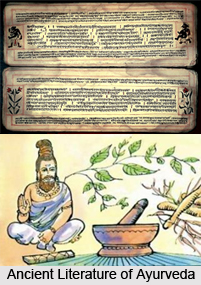 Treatment of ovarian tumours and cysts should be done immediately, owing to the delicate female reproductive system. Common symptoms include a swollen or bloated abdomen; pressure or pain in the abdomen, pelvis, back or legs; nausea, indigestion, gas, constipation or diarrhea; and feeling very tired all the time. Surgery and chemotherapy and rarely radiation therapy, are the standard line of treatment of ovarian tumours and cysts.
Treatment of ovarian tumours and cysts should be done immediately, owing to the delicate female reproductive system. Common symptoms include a swollen or bloated abdomen; pressure or pain in the abdomen, pelvis, back or legs; nausea, indigestion, gas, constipation or diarrhea; and feeling very tired all the time. Surgery and chemotherapy and rarely radiation therapy, are the standard line of treatment of ovarian tumours and cysts.
The Ayurvedic treatment of ovarian tumours and cysts is aimed at treating the cancer, preventing its spread and prolonging survival. Medicines like Triphala-Guggulu, Punarnavadi-Guggulu, Mahamanjishthadi-Qadha, Chandraprabha-Vati, Ashokarishta, Dashmoolarishta, Kuber-Vati, Kanchnar-Guggulu, Deodar (Cedrus deodara), Ashoka (Saraca indica), Varun (Crataeva nurvala) and Latakaranj (Caesalpinia crista) are used to treat ovarian tumours and cysts.
`Rakta` dhatu (tissue) are useful to treat this condition. These medicines include Patol (Tricosanthe dioica), Kutki (Picrorrhiza kurroa), Saariva (Hemidesmus indicus), Patha (Cissampelos pareira), and Musta (Cyperus rotundus). Medicines like Kanchnaar-Guggulu and Mahamanjishthadi-Qadha are used in high doses to check the spread of the disease locally or to other parts of the body. Ashwagandha (Withania somnifera), Shatavari (Asparagus racemosus), Suvarna-Parpati, Suvarna-Sutshekhar-Ras, Suvarna-Raj-Vangeshwar-Ras, Trivanga-Bhasma, Suvarna-Malini-Vasant, Suvarna-Bhasma and Heerak-Bhasma are used to improve the immune condition of the body so that this disease can be prevented. To prevent or reduce side effects from conventional therapy, medicines like Laxmi-Vilas-Ras, Ashwagandha, Shrung-Bhasma, Shankh-Vati and Laghu-Sutshekhar-Ras are also used.
Thus, Ayurvedic medicines can be used as additional therapy to modern, conventional treatment of ovarian tumours and cysts to bring about a faster response and to prevent recurrence, thus improving the quality of life and overall survival of the patient. It is significant to note that all such patients should be under the regular care and supervision of an Oncology team. Most ovarian cysts in women of childbearing age are follicular cysts (functional cysts) that withdraw naturally in one to three months. Although they can burst (usually without ill effects), they rarely cause symptoms. They are benevolent and have no real medical effect. They may be diagnosed coincidentally during a pelvic examination in women who do not have any related symptoms. All women have follicular cysts at some point that usually go unnoticed.
 A follicular cyst in a woman of childbearing age is usually observed for a few menstrual cycles because the cysts are very common, and ovarian cancer is rare in this age group. Sometimes ovarian tumours and cysts in menstruating women contain some blood, called hemorrhagic cysts, which often resolve quickly. Ultrasound is used to determine the treatment of ovarian tumours and cysts because it can help to determine if the cyst is a simple cyst (just fluid with no solid tissue, seen in benign conditions) or a compound cyst (with some solid tissue that requires closer monitoring and possibly surgical resection). The ideal treatment of ovarian tumours and cysts depends on the woman`s age, the size (and any change in size) of the cyst, and the cyst`s appearance after diagnosed on ultrasound.
A follicular cyst in a woman of childbearing age is usually observed for a few menstrual cycles because the cysts are very common, and ovarian cancer is rare in this age group. Sometimes ovarian tumours and cysts in menstruating women contain some blood, called hemorrhagic cysts, which often resolve quickly. Ultrasound is used to determine the treatment of ovarian tumours and cysts because it can help to determine if the cyst is a simple cyst (just fluid with no solid tissue, seen in benign conditions) or a compound cyst (with some solid tissue that requires closer monitoring and possibly surgical resection). The ideal treatment of ovarian tumours and cysts depends on the woman`s age, the size (and any change in size) of the cyst, and the cyst`s appearance after diagnosed on ultrasound.
Treatment of ovarian tumours and cysts can consist of simple observation, or it can involve evaluating blood tests such as a CA-125 to help establish the potential for cancer (keeping in mind the many limitations of CA-125 testing described above). The ovarian tumours and cysts can be surgically removed either with laparoscopy, or if needed, an open laparotomy (using an incision at the bikini line) if it is causing severe pain, not resolving, or if it is suspicious in any way. Once the cyst is removed, the growth is sent to a pathologist who examines the tissue under a microscope to make the final diagnosis as to the kind of cyst present.
In women of childbearing years, the most common treatment of large or painful ovarian tumours and cysts of three centimeters are likely to be surgical removal. In such cases, biopsy of the tissue may be necessary to rule out malignancy. Even gentle cysts and tumors can obstruct successful pregnancy, so an obstetrician may recommend surgery to remove ovarian tumours and cysts in women that are planning to have a child. For women that are not planning to have children, the most common course of action with benevolent fibroid tumors and cysts is to leave them intact. They are believed to cause no substantial increase in cancer risk, and the risks involved in a major surgery or hysterectomy are usually deemed greater than the risk or discomfort in leaving the tumors alone. Unless they are causing a great deal of pain, excessive bleeding between periods or other severe discomfort, the common course of action is to take no action at all.
If an ovarian tumor is found to be non-cancerous after a surgical biopsy is performed, it can usually be removed without causing damage to the ovary, and childbearing will still be possible. Still, many doctors prefer not to take chances with tumors and will recommend that women over 40 that have completed their child bearing have more hard line treatment, which may include the removal of one, or both ovaries. In women of childbearing years, the most common treatment of ovarian tumours and cysts of three centimeters or more is surgical removal. In such cases, biopsy of the tissue may be necessary to rule out malignant cells.
Treatment of ovarian tumours and cysts should never be neglected, since the low profile symptoms of this disease often gears up in the final stage, when surgery is usually adopted. However, it is always prescribed to go for natural medication in the initial stages.




















